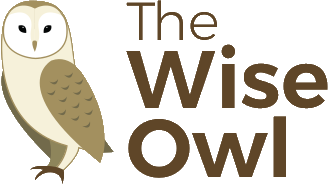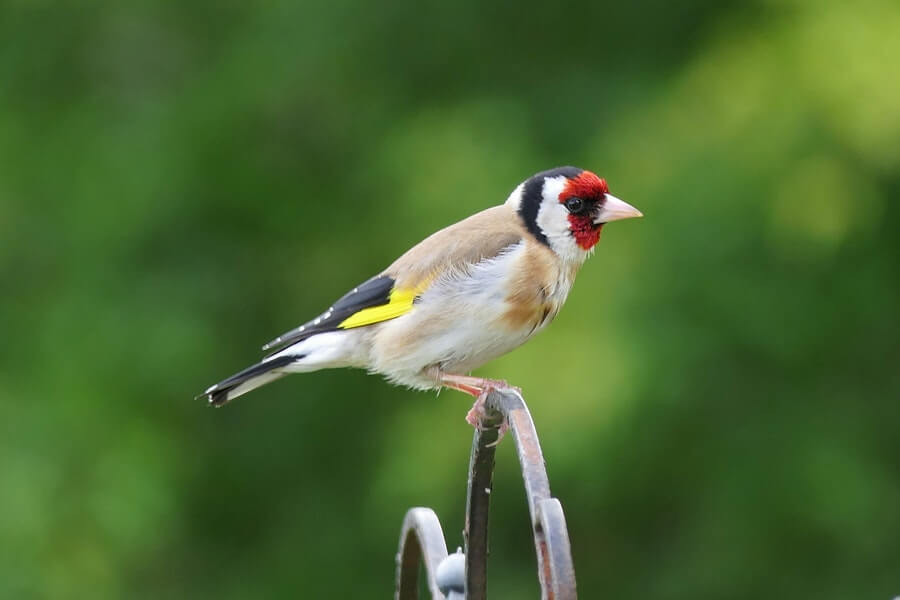The goldfinch is a beautiful bird, with its distinctive red face and yellow wings, ensuring it stands out in a crowd. These sociable birds are a favourite among bird watchers, and they’re becoming more common in British gardens. You can often spot them feeding in flocks, and the increase in supplemental food means you could be spotting a flock of goldfinches in your garden very soon! To help you distinguish these intriguing birds, we’ve put together a goldfinch identification guide, complete with our top tips on how to attract goldfinches to your garden for a brighter summer.
What Does A Goldfinch Look Like?
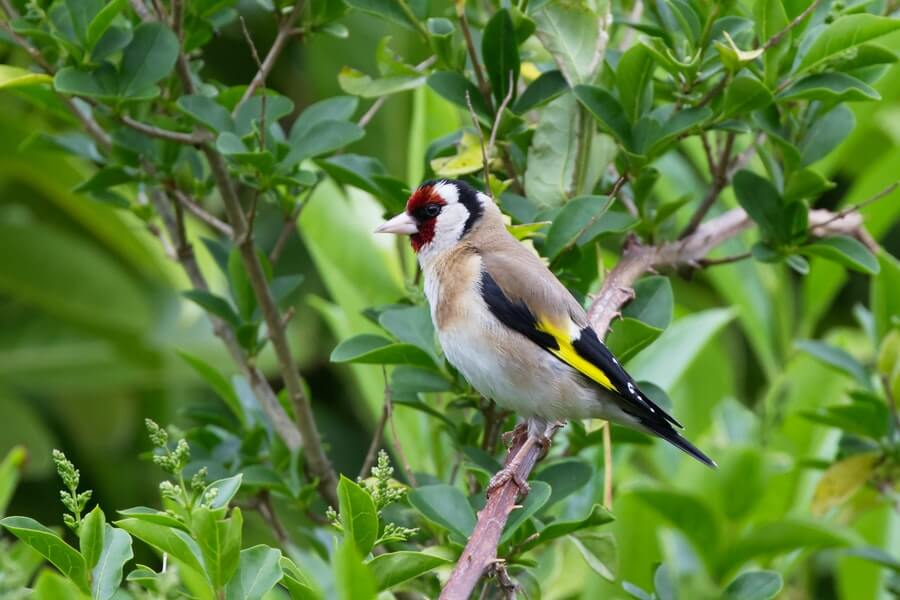
The goldfinch is a beautifully distinctive bird with a bright red face and black and white head. The beak is long and powerful, allowing them to get to otherwise unreachable seeds. Their wings are black with streaks of yellow and white, bodies a chestnut brown and breast a light brown colour. The goldfinch species are only small, reaching an average of around 12 cm in length[i].
Juvenile goldfinches have a mottled brown-grey face. Their wings are lighter than an adults but still distinguishable by the unique yellow patch.
What Does A Goldfinch Sound Like?

You can often recognise the goldfinch for its delightful sounds, including a pure twittering song and tinkling calls. A goldfinches call is a ‘tik-a-wik’ sound with a bouncing, urgent quality. Goldfinch calls are distinctive since they’re often delivered in unison from flocks, meaning that you can hear a goldfinch song quite clearly once you are accustomed to the sound.
What Do Goldfinches Eat?

The beak of a goldfinch is specially adapted to reach their main food source – seeds. Goldfinches can use their long, thin beak to get otherwise inaccessible seeds from plants such as teasels and thistles. In spring and summer, goldfinches will feed their young insects until they can fly the nest after about 18 days.
Do Goldfinches Migrate to The U.K.?

Goldfinches are partial migrants, which means that only some of our goldfinch population migrate each winter. Surprisingly, the majority of migratory goldfinches are females. These migratory goldfinches will move on to warmer climates in the southwest of Europe, usually France and Spain, though sometimes Belgium. Goldfinches leave in the U.K. in September-October and start for home in early spring, just before the breeding season.
However, goldfinches that migrate one year may not migrate the next; they are irregular migrators. Although there is no certain reasoning for their migratory habitats, experts believe that goldfinches will migrate depending on the severity of the winter.
Those that stay in the U.K. usually seek out warmer parts of the U.K., meaning you have a good chance of spotting a goldfinch in the South during winter.
Where Can You Find Goldfinches?
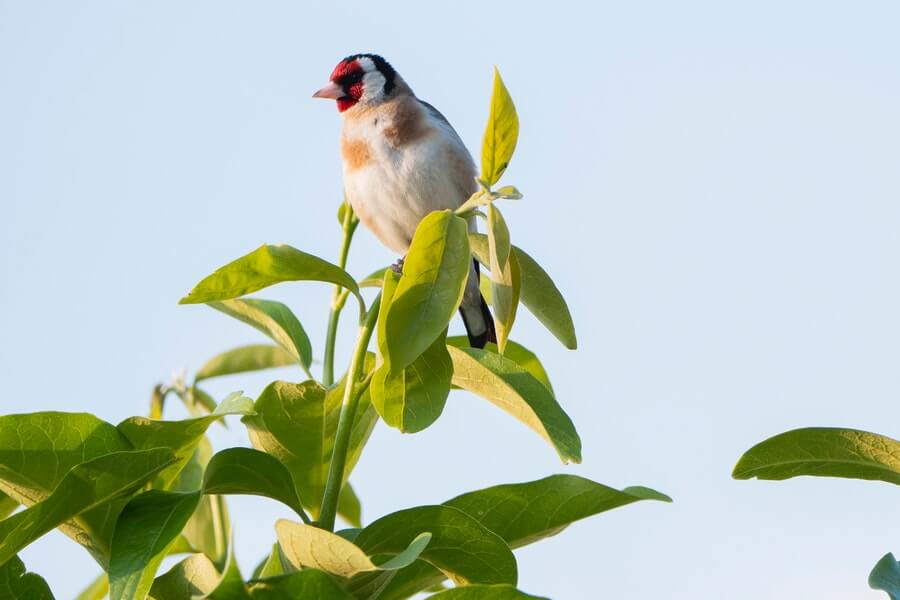
Goldfinches are widespread across the U.K. (although they are most numerous in the South of England) and can be seen almost anywhere throughout the year. To find a goldfinch, look at areas with plenty of seeding plants, wildflowers, and scattered bushes and trees. For example, you’re likely to spot a goldfinch in parks, commons, and orchards.
How To Attract Goldfinches To Your Garden
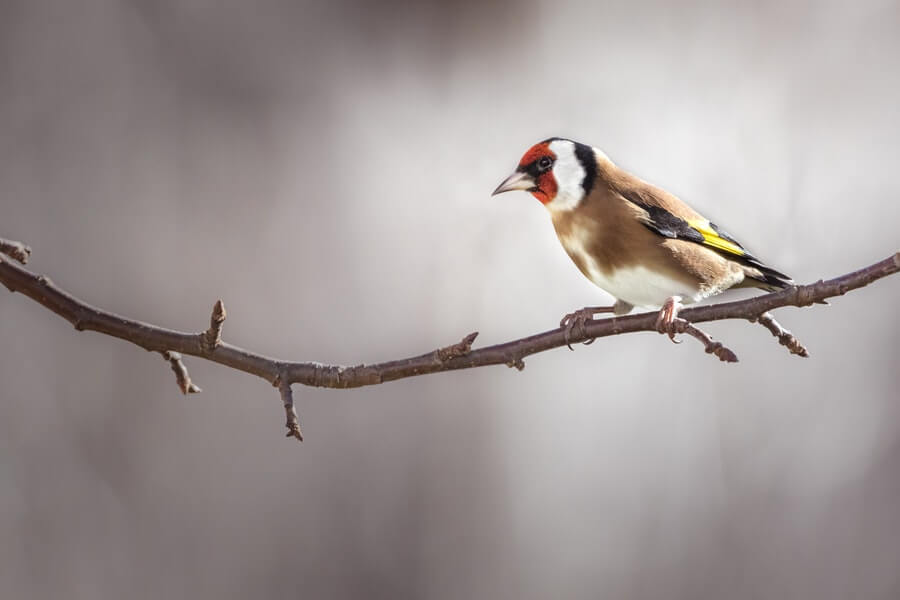
Goldfinches are becoming an increasingly popular visitor to garden bird feeders and tables. Gardeners and birders look forward to spotting goldfinches as the summer draws closer, but there are things you can do to attract goldfinches to your garden sooner.
- Leave Out The Right Food – There are plenty of seed mixes that you can leave out to attract a range of birds. However, if you desire to see a goldfinch at your feeder, your best bet is to leave out Niger seed. All types of finches love these seeds, and you’re sure to draw the attention of a goldfinch or two.
- Plant Some Goldfinch-Friendly Plants – Goldfinches love feasting on seeds straight from the plant, so include some of their favourite seed-producing plants in your garden. Some favourites of the goldfinch include teasels, dandelions and groundsels.
- Include A Bird Bath – Bird baths are essential for attracting a range of birds since they need somewhere to have a drink and wash their feathers. Make sure you clean your bird bath and feeders regularly to reduce the spread of disease.
- Hang Your Feeders Right – When hanging a feeder for goldfinches, try and hang them above head height. This way, any potential visitors won’t be intimidated by predators.
- Be Patient – It can take goldfinches a week or two to notice your new offerings, so don’t worry if you don’t spot a goldfinch straight away. You could try tying something bright to your feeders, such as a piece of ribbon, to draw their attention.
Find out more about how to attract goldfinches to your garden.
Spotting A Goldfinch

Goldfinches are incredible birds, and spotting one is a thrilling experience for any avid bird watcher. So now you know what to look and listen out for; you’re on your way to telling your goldfinch from your siskin!
Have you spotted a goldfinch in your garden recently? Please share your experiences with us!
Sources
[i] https://bird-hub.com/how-long-do-goldfinches-live/
Gemma Sharp is the resident writer for Love Garden Birds, a supplier of premium bird food and accessories. She has had a genuine love for our feathered friends from a young age, and has dedicated a lot of her time to learning all there is to know about them. If you’re struggling to pick the right bird feed for your garden, need help identifying a type of wild bird, or can’t decide where to put a nesting box, Gemma is the person to go to! She is passionate about sharing her years of learnt knowledge with the public. In her free time, she can be found feeding birds at home with her three young boys.
